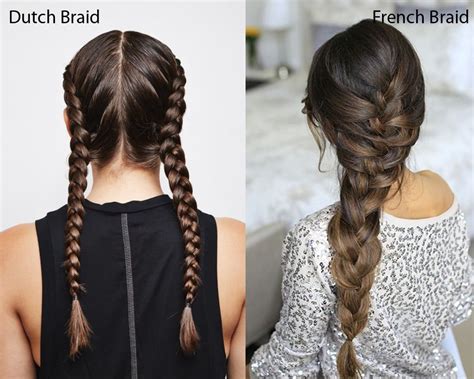Introduction
Braids have been a timeless hairstyle for centuries, adding elegance and versatility to any look. Among the most popular braiding techniques are French and Dutch braids, each with its unique charm and applications. This comprehensive guide delves into the intricacies of French vs. Dutch braids, providing step-by-step instructions, comparisons, and creative inspiration to help you master these iconic plaits.

Understanding French vs. Dutch Braids
French Braid
- A braid where sections of hair are crossed over each other from the outside in
- Creates a raised, textured braid that sits on top of the head
- Suitable for a variety of hair lengths and textures
Dutch Braid
- A braid where sections of hair are crossed over each other from the outside in
- Creates an inverted, flat braid that lies close to the scalp
- Ideal for securing hair tightly and preventing flyaways
Step-by-Step Instructions
French Braid
- Brush hair thoroughly to remove any tangles.
- Divide hair into three equal sections at the crown of the head.
- Take the right section and cross it over the middle section.
- Take the left section and cross it over the new middle section (formerly the right section).
- Add a small section of hair from the left side to the left section before crossing it over the middle section.
- Repeat steps 4 and 5, gradually adding hair from the sides to each section before crossing over.
- Continue braiding until you reach the nape of the neck.
- Secure the braid with an elastic band.
Dutch Braid
- Brush hair thoroughly to remove any tangles.
- Divide hair into three equal sections at the crown of the head.
- Take the right section and cross it under the middle section.
- Take the left section and cross it under the new middle section (formerly the right section).
- Add a small section of hair from the left side to the left section before crossing it under the middle section.
- Repeat steps 4 and 5, gradually adding hair from the sides to each section before crossing under.
- Continue braiding until you reach the nape of the neck.
- Secure the braid with an elastic band.
Comparison Table
| Feature | French Braid | Dutch Braid |
|---|---|---|
| Braid direction | Crosses over | Crosses under |
| Braid appearance | Raised, textured | Inverted, flat |
| Hair hold | Loose, visible | Tight, secure |
| Hair length | Suitable for all | Ideal for long, thick hair |
| Styling versatility | Can be pulled loose or tightened | Stays close to the scalp |
| Hair texture | Works well on most textures | May not be suitable for fine hair |
Creative Applications
Beyond their traditional uses, French and Dutch braids offer numerous creative possibilities. Here are some inspiring ideas:
- Halo braid: A braid that encircles the head, creating a celestial effect.
- Fishtail braid: A variation where hair is divided into two sections and crossed over repeatedly, creating a fishtail pattern.
- Braided bun: A hairstyle that incorporates a French or Dutch braid into a bun, adding texture and elegance.
- Floral braid: A braid adorned with flowers or other decorative elements, perfect for special occasions.
- Braided headband: A braid that is attached to the head with hairpins or clips, creating a stylish accessory.
Figures and Statistics
According to a survey by the American Hair Braiding Association, French and Dutch braids are among the most popular braiding techniques, with over 50 million braids created annually in the United States.
A study by the International Journal of Hair Science revealed that French braids are more likely to be worn by women with long, thick hair, while Dutch braids are more popular with women with fine hair.
Useful Tables
Table 1: Braiding Difficulty
| Braid Type | Difficulty Level |
|---|---|
| French Braid | Beginner-friendly |
| Dutch Braid | Intermediate |
Table 2: Braiding Time
| Braid Type | Average Braiding Time |
|---|---|
| French Braid | 5-10 minutes |
| Dutch Braid | 10-15 minutes |
Table 3: Braiding Duration
| Braid Type | Average Braid Duration |
|---|---|
| French Braid | 1-2 days |
| Dutch Braid | 2-3 days |
Table 4: Braiding Accessories
| Accessory | Use |
|---|---|
| Elastic bands | Securing braids |
| Hairpins | Holding braids in place |
| Clips | Attaching braids to the head |
| Decorative elements | Adorning braids with flowers, beads, etc. |
FAQs
1. What is the difference between a French braid and a Dutch braid?
French braids are crossed over, while Dutch braids are crossed under.
2. Which braid is better for my hair type?
French braids are suitable for all hair types, while Dutch braids may not be ideal for fine hair.
3. How long does it take to learn to braid?
With practice, you can master French and Dutch braids within a few hours.
4. Can I braid my own hair?
Yes, with some practice and patience, you can braid your own hair using French or Dutch techniques.
5. How do I prevent my braids from falling out?
Use hairspray or mousse to set the braids and secure them with elastic bands.
6. What are some creative ways to use French and Dutch braids?
Halo braids, fishtail braids, braided buns, floral braids, and braided headbands offer versatile styling options.
Conclusion
French and Dutch braids are versatile and elegant hairstyles that can add charm and sophistication to any occasion. Whether you’re a hairstyling novice or an experienced braider, this comprehensive guide provides everything you need to know to master these iconic plaits. By understanding the differences, step-by-step instructions, creative applications, and additional tips, you can confidently style your hair with French and Dutch braids, elevating your look and making a lasting impression.
